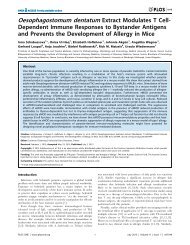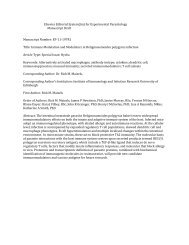Cystatins from filarial parasites - Rick Maizels' Group - University of ...
Cystatins from filarial parasites - Rick Maizels' Group - University of ...
Cystatins from filarial parasites - Rick Maizels' Group - University of ...
You also want an ePaper? Increase the reach of your titles
YUMPU automatically turns print PDFs into web optimized ePapers that Google loves.
W.F. Gregory, R.M. Maizels / The International Journal <strong>of</strong> Biochemistry & Cell Biology 40 (2008) 1389–1398 1391<br />
structure <strong>of</strong> ∼100 aa; (3) two internal disulphide bonds;<br />
(4) an invariant glycine residue within the first 10–15<br />
residues <strong>of</strong> the mature protein; (5) a central Gln-X-<br />
Val-X-Gly motif; (6) a C-terminal Pro-Trp hairpin loop<br />
pair. The latter three regions together protrude into the<br />
active site cleft <strong>of</strong> the protease to achieve inhibition<br />
(Bode et al., 1988). The <strong>filarial</strong> cystatins conform with<br />
each <strong>of</strong> these structural patterns, except that only one<br />
disulphide bond exists, as the second C-terminal cysteine<br />
residue pair that spans the P-W residues is absent<br />
(Fig. 1A).<br />
More surprisingly, Bm-CPI-1 and CPI-3 are missing<br />
the N-terminal glycine residue, with the replacement <strong>of</strong><br />
a glycine by a serine residue at position 6 in the mature<br />
Bm-CPI-1 (Fig. 1A). In solution, the lack <strong>of</strong> any side<br />
chain in Gly-6 is thought to confer structural flexibility<br />
to the N-terminal trunk <strong>of</strong> the protein. In complexes with<br />
proteases, however, the N-terminus is immobilized by<br />
interactions <strong>of</strong> residues directly preceding the glycine<br />
with the substrate-binding sites <strong>of</strong> cysteine proteases<br />
(Bode et al., 1988).<br />
In mammalian cystatins, mutations in residues up<br />
to and including the glycine decrease or abolish the<br />
ability <strong>of</strong> the inhibitor to interact with a variety <strong>of</strong> substrates,<br />
as the presence <strong>of</strong> an amino acid side-chain<br />
at this position impedes structural flexibility (Bode et<br />
al., 1988; Hall, Dalboge, Grubb, & Abrahamson, 1993;<br />
Hall, Hakansson, Mason, Grubb, & Abrahamson, 1995;<br />
Shibuya et al., 1995). However, the glycine residue<br />
<strong>of</strong> cystatin C is not necessary for inhibition <strong>of</strong> the<br />
aminopeptidase cathepsin C (dipeptidyl peptidase I)<br />
(Hall et al., 1993). In addition, truncation <strong>of</strong> the Nterminal<br />
residues <strong>of</strong> cystatin C does not affect cathepsin<br />
C or cathepsin H inhibition (Abrahamson et al., 1987,<br />
1991). These studies suggest that, despite the substitution<br />
<strong>of</strong> glycine for serine in Bm-CPI-1, this product<br />
may still function as an inhibitor <strong>of</strong> a cathepsin C-like<br />
enzyme.<br />
In some mammalian cystatins, such as cystatin C,<br />
a second inhibitory site has been demonstrated which<br />
blocks legumain or asparaginyl endopeptidase (AEP)<br />
enzymes (Alvarez-Fernandez et al., 1999). This lies on<br />
the opposite side <strong>of</strong> the protein to the papain-binding<br />
site (Fig. 1B), and contains an asparagine essential for<br />
legumain inhibition within the motif SND (Alvarez-<br />
Fernandez et al., 1999). It is interesting to note that the<br />
same motif is present in <strong>filarial</strong> cystatins <strong>of</strong> the CPI-2<br />
type (amino acids 83-86 in Fig. 1A). Indeed, Bm-CPI-<br />
2 has been shown to block the activity <strong>of</strong> mammalian<br />
legumain and the related enzyme, asparaginyl endopeptidase<br />
in antigen-presenting cells (Manoury et al., 2001),<br />
and site-directed mutagenesis studies have established<br />
that, as with the mammalian inhibitor, the asparagine<br />
residue <strong>of</strong> Bm-CPI-2 is essential for AEP inhibition but<br />
is not required for cathepsin B, L or S inhibition (Murray,<br />
Manoury, Balic, Watts, & Maizels, 2005).<br />
A further unusual feature <strong>of</strong> Bm-CPI-2 and its homologues<br />
<strong>from</strong> 3 other <strong>filarial</strong> nematodes is the insertion<br />
<strong>of</strong> a short (15–20 aa) N-terminal peptide. Currently, we<br />
are unable to assign a functional property to this tract,<br />
although one possibility is that it allows the protease<br />
inhibitor to interact more effectively with target cells<br />
<strong>of</strong> the immune system. For example, if this inserted<br />
sequence were to be recognised by innate receptors <strong>of</strong><br />
mammalian antigen-presenting cells, the CPI-2 proteins<br />
might gain access to intracellular compartments containing<br />
target cathepsins and AEP. Experiments are now<br />
under way to test this supposition.<br />
1.3. Comparison with C. elegans and other<br />
non-<strong>filarial</strong> nematodes<br />
Two cystatin-like sequences <strong>from</strong> the free-living<br />
nematode C. elegans have been readily identified, and<br />
designated Ce-CPI-1 and -2 (Murray et al., 2005). The<br />
predicted proteins are 48% identical to each other and,<br />
like the <strong>filarial</strong> cystatins, are marked by the presence<br />
<strong>of</strong> only one pair <strong>of</strong> cysteines. The canonical features <strong>of</strong><br />
an N-terminal Glycine, a central Gln-Val-Val-Ala-Gly,<br />
and a C-terminal P-W pair are all present (Fig. 1). Interestingly,<br />
on the opposite face to the central QVVAG,<br />
Ce-CPI-1 encodes SNN, and Ce-CPI-2 NNG, at the position<br />
where Bm-CPI-2 has a functional AEP-inhibiting<br />
motif, SND. Testing <strong>of</strong> recombinant C. elegans cystatins,<br />
expressed in bacteria, revealed however that neither Ce-<br />
CPI-1 nor -2 were able to block AEP, although both were<br />
effective at inhibiting cathepsin S (Murray et al., 2005).<br />
However, Ce-CPI-2 (also named CPI-2a in distinction<br />
to a truncated is<strong>of</strong>orm predicted to be nonfunctional)<br />
has been shown to be essential in oocyte maturation<br />
and fertilization, with cpi-2 mutant worms being sterile<br />
(Hashmi, Zhang, Oksov, Ji, & Lustigman, 2006).<br />
Further comparisons between <strong>filarial</strong> and C. elegans cystatins<br />
are described below, in the context <strong>of</strong> immune<br />
evasion (Hartmann & Lucius, 2003; Schierack, Lucius,<br />
Sonnenberg, Schilling, & Hartmann, 2003).<br />
In addition to C. elegans, cystatins have been identified<br />
in two non-<strong>filarial</strong> nematode <strong>parasites</strong>, both<br />
gastrointestinal worms <strong>of</strong> animal hosts. Haemonchus<br />
contortus, a prominent gut parasite <strong>of</strong> sheep, expresses<br />
Hc-CPI (Newlands, Skuce, Knox, & Smith, 2001), while<br />
Nippostrongylus brasiliensis, a common model system<br />
which infects rodents, expressed Nb-CPI (Dainichi et al.,<br />
2001).





